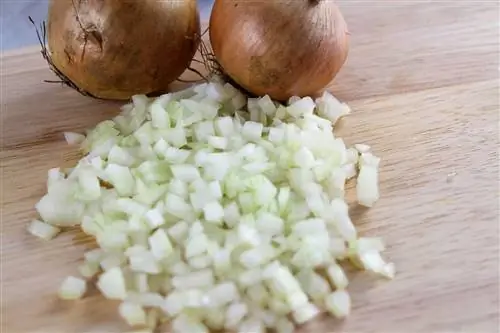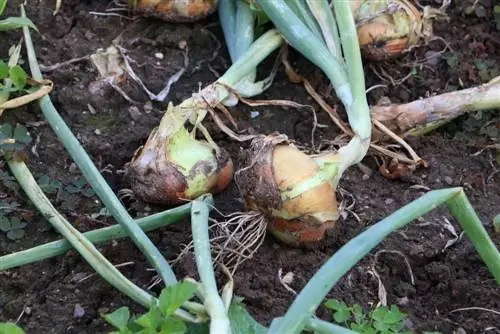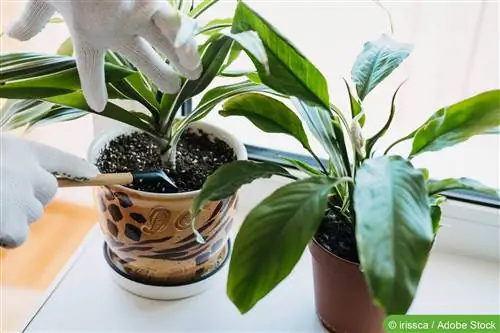- Author admin [email protected].
- Public 2023-12-17 03:39.
- Last modified 2025-01-24 12:45.
Cutting onions is a tiresome task because the spicy juice stings your eyes so much that it causes tears after a short time. This article explains how this can be avoided.
The reason for the tears
It is common knowledge that cutting onions leads to tears, but not the reason why. Onions protect themselves from being eaten by animals with certain ingredients. These substances are released when the plant cells are injured, for example by a bite or a cut. When exposed to air, the plant substances react with each other and form an irritating gas, which in turn leads to watery eyes.
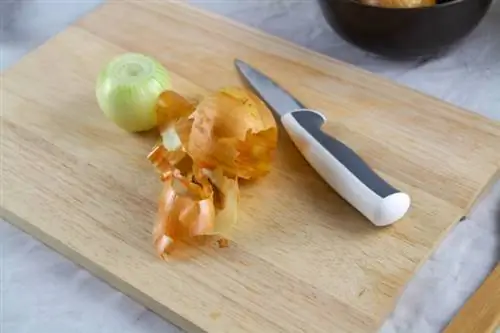
Running water
Since the ingredients in the onion only become effective when exposed to air, the easiest way to avoid tears is to cut the onions under water or under running water. A bowl of water is more water-saving than running water. However, it is not that easy to cut an onion in water, which is why this option is not always practical. However, it is enough to peel an onion and cut it into larger pieces without tears.
Rinse with water
It is easier if the onion, the knife and the cutting mat are regularly rinsed with water. There may still be a few tears, but significantly less than if you work completely without water.
The right knife
The sharper the knife, the faster the work goes and the less the plant cells are injured when cutting. This means that fewer of the irritating substances are released.

Ventilation
When the air is in motion, the enzymes and gases that form from them cannot collect near the eyes and cause tears. Therefore the following options are suitable:
- working at an open window
- Turn on the extractor hood in the kitchen at the highest setting and work below it
- use a fan
Use tools
There are various ways to chop onions without having to use a knife. Vegetable cutters with a closed housing prevent the onion substances from evaporating. The onion only needs to be peeled by hand and halved or quartered. It is then placed in the onion cutter, the flap is closed and the blades are operated by crank, cable or electrically, depending on the model.
Note:
A disadvantage of vegetable cutters is the increased cleaning effort. However, you can cut larger quantities of onions much more quickly.
Use safety glasses
Safety glasses can be used to prevent the enzymes from the onion from reaching the eyes. However, this must enclose the eyes in an airtight manner, like diving goggles do.
Breathing technique
The correct breathing technique protects the mucous membranes of the nose from the harsh fumes of the onion and thus leads to fewer tears. It is important to always breathe through your mouth.
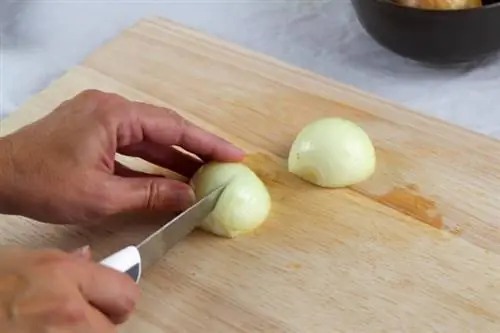
Tip:
If this is difficult, you can use a clothespin on your nose as an aid.
Use the cold
Onions should not be kept in the refrigerator for storage, but chilling them for an hour before cutting helps prevent the enzymes in the onion from reacting as quickly. It's best to put knives and cutting boards in the fridge too.
Frequently asked questions
Do all types of onions cause tears when cutting?
All types of onions that contain the irritating substances cause tears when cutting. However, since onions differ in their spiciness, they also contain different amounts of the responsible ingredients. The less spicy the onion, the less tears it causes.
What role does storing the onion play?
Onions that are stored for a long time lose some of their ingredients, including the harsh enzymes that cause tears. This means that onions that have been stored for a long time are easier to cut. However, they are no longer as spicy or aromatic.
Does a sip of water or a piece of bread in your mouth help?
In fact, both methods can help some people, but not others. The only way to find out if it works is to try it out.

